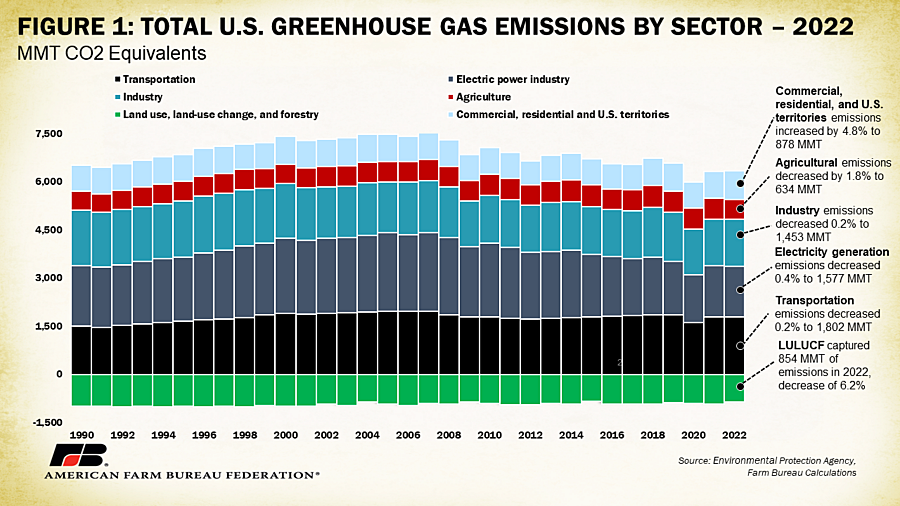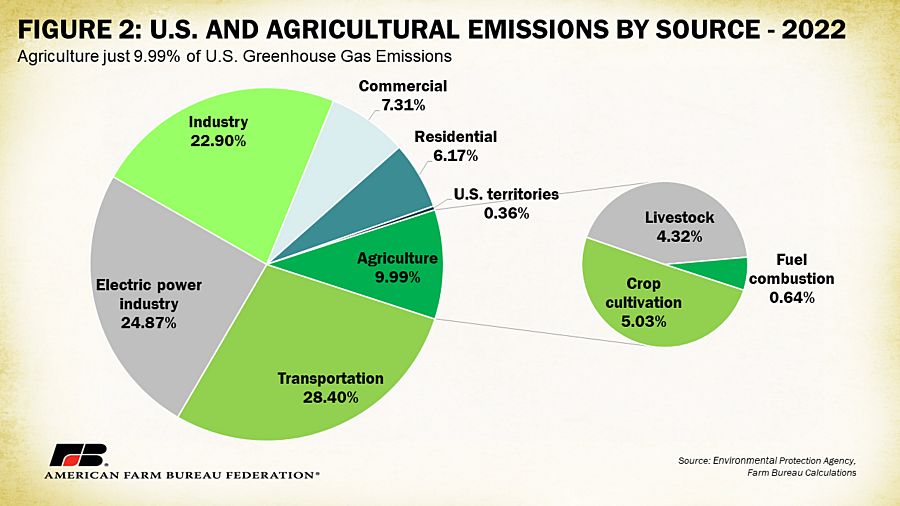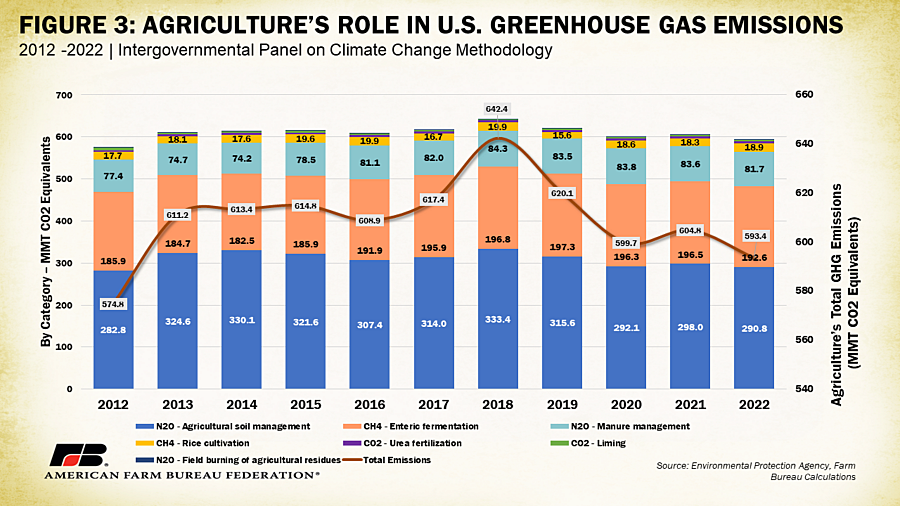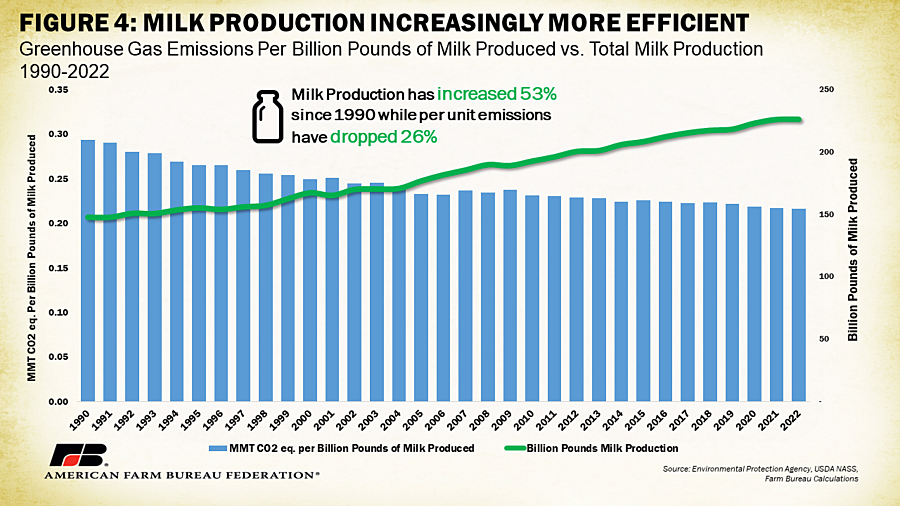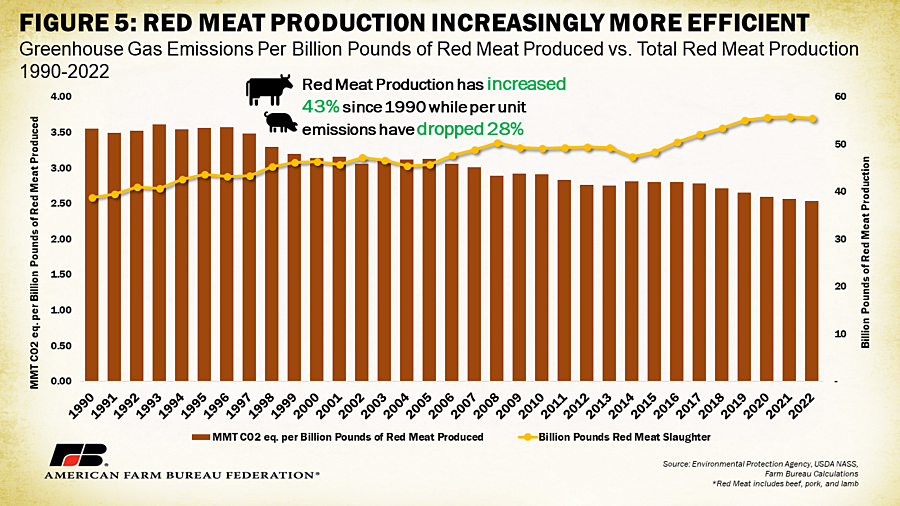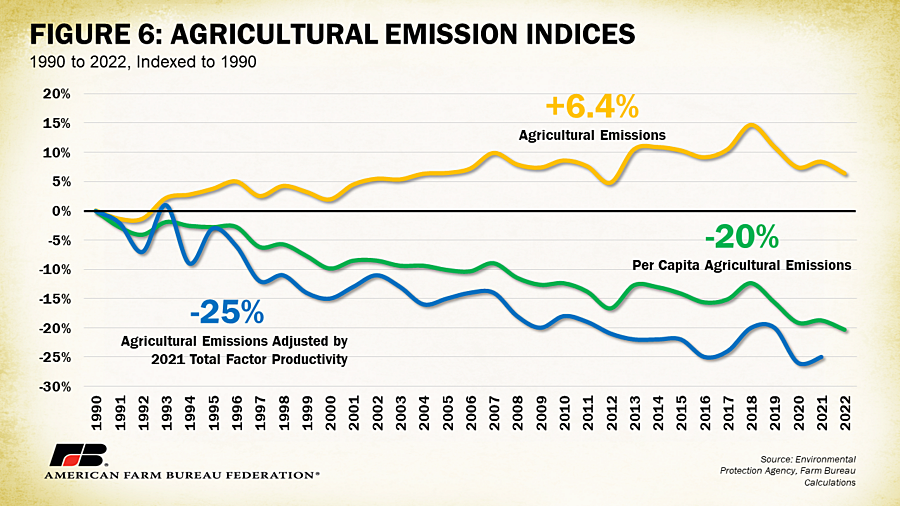2022 EPA Emissions Inventory Highlights Agriculture's Sustainability Strides
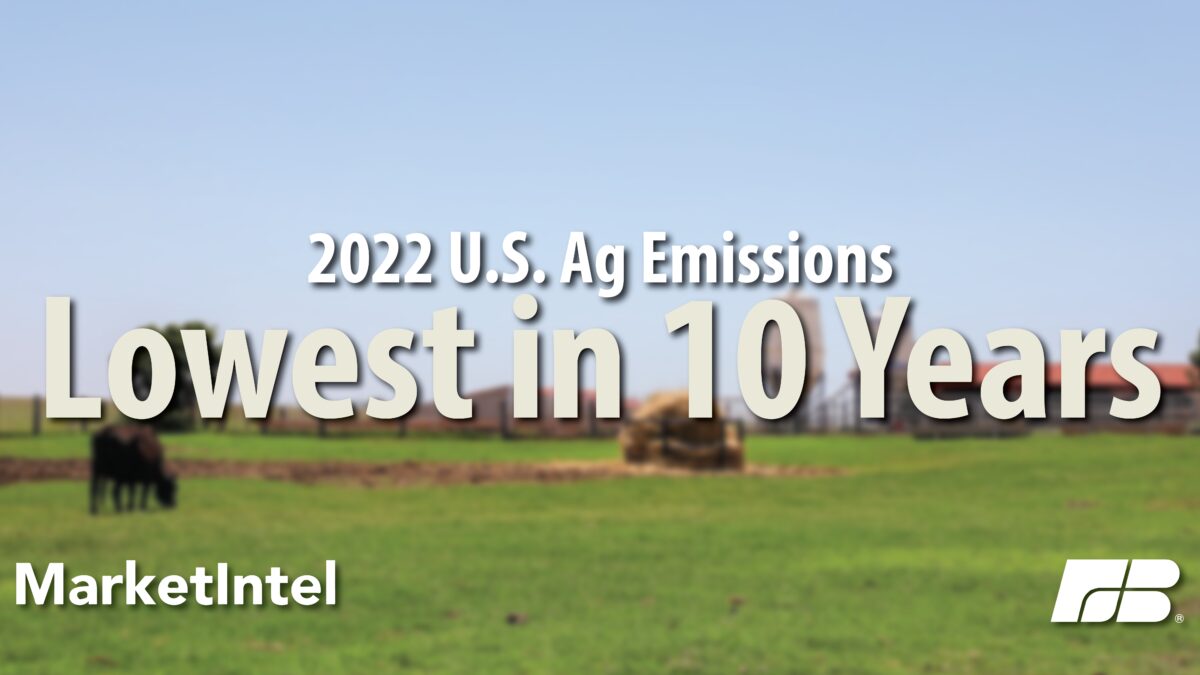
Daniel Munch
Economist
On April 11, the Environmental Protection Agency published the latest edition of the Inventory of U.S. Greenhouse Gas Emissions and Sinks: 1990-2022. The report has been published annually since 1990 and provides an annual estimate of all man-made greenhouse gas emission sources in the U.S. as well as estimates of the amount of carbon trapped in forest and vegetation soil. This report is submitted to the United Nations as part of the United Nations Framework Convention on Climate Change reporting guidelines on annual inventories, which is part of a global standardized process for reporting greenhouse gas emissions. Previous Market Intel articles have reviewed the emissions for 2017 (Agriculture and Greenhouse Gas Emissions), 2018 (Agriculture’s Greenhouse Gas Emissions and Sinks), 2019 (Previewing 2019 Agricultural Emissions), 2020 (2020 EPA Emissions Inventory Demonstrates Agriculture’s Advancements in Sustainability) and 2021 (2021 EPA Emissions Inventory Demonstrates Agriculture’s Continuing Advancements in Sustainability), as well as trends in carbon sequestration (Reviewing U.S. Carbon Sequestration).
U.S. agriculture represents just under 10% of total U.S. emissions when compared to other economic sectors. Overall U.S. greenhouse gas emissions increased from 2021 to 2022 by 1.3%, though agricultural emissions dropped 1.8% - the largest decrease of any economic sector. The aggregate nationwide emissions increase in 2022 was likely a result of the continued return of economic activity after the COVID-19 pandemic; with the slow return of food service, entertainment and travel came the emissions associated with those activities. Agricultural production remained vital throughout the COVID-19 disruptions and lockdowns as the world still required food. Net emissions were 17% below 2005 levels.
The nearly 2% drop in U.S. agricultural emissions from 2021 to 2022 highlights the success and continued importance of voluntary, market- and incentive-based conservation practices that help farmers and ranchers access finances for the research and technology needed to take ever-better care of our natural resources. 2022 marks the lowest U.S. agricultural greenhouse gas emissions since 2012.
This article provides an overview of 2022 emissions as detailed in EPA’s Inventory of U.S. Greenhouse Gas Emissions and Sinks: 1990-2022 report. It is important to note, each year EPA updates the methodologies used for their estimations and retroactively applies this updated methodology to all years since 1990. This means that data in this iteration of the report is not comparable to the values reported last year.
2022 Emissions and Sinks
In 2022, EPA reports, total U.S. emissions from all man-made sources was 6.34 billion metric tons in CO2 equivalents, which is a 14-million-metric-ton increase compared to 2021 when U.S. emissions totaled 6.32 billion metric tons in CO2 equivalents. Land use, land-use changes and forestry (LULUCF) trapped 854 million metric tons of carbon in the soils, representing 13% of total U.S. emissions. 2022 net emissions, which combine total U.S. greenhouse gas emissions with the sequestered greenhouse gas emissions, totaled 5.5 billion metric tons, up 1.3% from 2021. Again, this increase is likely linked to the continued rebound of economic activity after initial COVID-19 economic disruptions.
The largest emissions source was the transportation sector, representing 28% of total emissions and totaling 1.8 billion metric tons. Transportation emissions declined 0.2%, or 4 million metric tons, from the prior year. Following transportation, electricity generation represented 25% of total emissions at 1.57 billion metric tons. Emissions from the electric power industry were down 0.4% from 2021 after a 6.9% increase between 2020 and 2021. The industrial sector, which includes the production of iron and steel, as well as other input materials like cement, represented 23% of all emissions at 1.45 billion metric tons. Emissions from the industrial sector declined 0.2% compared to 2020. The commercial and residential sectors and U.S. territories represented 14% of all U.S. emissions, increasing a significant 4.8% compared to 2021. Emissions in this category are heavily linked to building-related activities such as heating, cooling and cooking. U.S. territory emissions, including emissions from American Samoa, Guam, Puerto Rico, the U.S. Virgin Islands and Northern Mariana Islands, make up only 0.4% of total emissions.
Agricultural Emissions in 2022
By EPA’s own methodology, emissions from agriculture totaled 634 million metric tons in CO2 equivalents, or 9.99% of all U.S. emissions, during 2022. This represents a decrease of 1.8%, or 12 million metric tons, from 2021. This follows a 0.9%, or 6-million-metric-ton, increase between 2020 and 2021 and a 3.2%, or 21-million-metric-ton, drop between 2019 and 2020. EPA further categorizes agricultural emissions by crop cultivation, livestock and fuel combustion. In 2022, crop cultivation emissions totaled 319 million metric tons, down 1.7%, or 6 million metric tons, from 2021 and just over 5% of total emissions. At 4.3% of total emissions, livestock emissions were 274 million metric tons, down 2.1%, or 6 million metric tons, from 2021. This is likely linked to smaller livestock inventories, particularly beef cattle, which were liquidated at higher rates in 2022 due to drought conditions. Fuel combustion utilized by the agricultural sector contributed 41 million metric tons in 2022, down 1 million metric tons, or 1.2%, from 2021, a mere 0.64% of total emissions.
For livestock categories specifically, enteric emissions from beef cattle sat at 2.19% of total U.S. emissions in 2022, or 137 million metric tons of the 6.34 billion metric ton total. This is a 2.43%, or 3.3-million-metric-ton, decline from 2021. Dairy cattle contributed only 0.77% of total emissions or 49 million metric tons – a 451,000-metric-ton decrease from 2021. Swine, sheep and horses were a mere 0.05%, 0.02% and 0.02% of the total, respectively.
EPA also estimates agricultural emissions using a second methodology consistent with that of the Intergovernmental Panel on Climate Change. By this measure, U.S. agricultural emissions for 2022 totaled 593 million metric tons, down 1.9%, or 11 million metric tons, from 2021, representing 9.3% of all U.S. greenhouse gas emissions. This methodology breaks down agriculture into additional categories not considered in the base methodology. In this data set, the largest source of U.S. agricultural emissions was agricultural soil management, e.g., fertilizer applications or tillage practices, at 290 million metric tons, a 7.2-million-metric-ton, or 2.4%, decrease. Agricultural soil management represents approximately 50% of all agricultural emissions, but only 4.6% of total U.S. emissions.
Following agricultural soil management, livestock-related emissions from enteric fermentation and manure management contributed 192 million metric tons and 82 million metric tons, respectively, to total U.S. emissions. These two emission sources represented 46% of agricultural emissions, but only 4.3% of total U.S. emissions. Other agricultural emission sources include methane from rice cultivation at 19 million metric tons, CO2 from urea fertilization at 5.3 million metric tons, CO2 from liming at 3.3 million metric tons, and CO2 from field burning at 0.8 million metric tons. Combined, these remaining categories represented less than 5% of agricultural emissions and 0.4% of U.S. emissions.
Agricultural Productivity and Emission Trends
A comparison of 2022 emissions to 1990 emissions shows U.S. agricultural emissions have increased by 6.4%. However, that’s not the full story. Productivity is increasing, as it must to keep feeding a growing global population, and emissions are on the decline relative to this productivity and population increase. Innovation and advancements in technology have allowed farmers and ranchers to increase their productivity while using the same amount of inputs. Compared to 1948, farmers and ranchers are producing nearly three times more in output per unit of input they use, according to USDA-Economic Research Service’s estimations of farm output, input and total factor productivity (Agricultural Productivity in the U.S.). Even more impressive, productivity – and production – is rising while agricultural land used is declining. Acreage in operation has declined by 323 million acres since 1950, almost double the size of Texas. This means that farmers and ranchers continue to produce more using fewer resources and the additional decrease in agricultural emissions shows that voluntary, market-based incentives are helping farmers and ranchers accomplish this.
Production of food is important not just for farmers and ranchers, but also for the millions of families in the U.S. and around the world that U.S. agriculture feeds. Agriculture’s sustainable intensification through productivity gains, in addition to the adoption of practices that further shrink farmers and ranchers’ environmental footprint, has had remarkable results in crop yields and animal nutrition and breeding. It’s important to note the public and private agricultural research that drives these gains, which are critical to the sustainability of U.S. agriculture and its contribution to meeting the world’s food, clothing and energy needs.
Consider two examples: milk production and red meat production, which includes cattle, swine and sheep raised for meat. Between 1990 and 2022, U.S. dairy farmers have increased milk output by 53%, going from 148 billion pounds to 226 billion pounds to meet increasing global demand for products like cheese, butter and dairy powders. During this same timeframe, emissions from enteric fermentation from dairy cattle per billion pounds of milk produced have dropped 26%, going from 293 million metric tons to 216 million metric tons per billion pounds of milk produced. Similarly, global demand for red meat products continues to rise and farmers have met the challenge in a more efficient manner. In 1990, U.S. farmers produced 39 billion pounds of red meat; this grew 44% to 55.6 billion pounds in 2022. In the same timeframe, greenhouse gas emissions from enteric fermentation from beef cattle dropped 28%, going from 3.5 million metric tons to 2.5 million metric tons per billion pounds produced. This shows how livestock producers have embraced technological innovation and production practices that increase output while reducing associated emissions.
Not only have producers focused on improvements to production and sustainability, but they have also focused on feeding more families, both at home and abroad. Since 1990, U.S. agricultural emissions have increased by 6.4% while the U.S. population increased 33%, adding over 83 million people in three decades. This means U.S. agriculture has been called upon to feed more people than ever before. With the advancements in innovation and technology, agricultural emissions per capita have declined 20% since 1990. Adjusting for productivity gains within the sector, the 6.4% increase in agricultural emissions drops to a 25% decline since 1990 (latest available productivity data is 2021).
Summary and Policy Conclusions
During 2022, U.S. greenhouse gas emissions from all man-made sources totaled 6.34 billion metric tons in CO2 equivalents, an increase of 0.2% from 2021, according to the methodology used by the Environmental Protection Agency. When taking into consideration carbon trapped in the soils through forestry, grasslands, wetlands and cropland, U.S. greenhouse gas emissions were reduced by 13% to a net emissions level of 5.5 billion metric tons. Emissions related to agriculture totaled 634 million metric tons during 2022, down 1.8% from the previous year.
Based on Intergovernmental Panel on Climate Change methodology, U.S. agricultural emissions totaled 593 million metric tons in 2022, a 1.9% decrease compared to 2021. As a percentage of total U.S. emissions, U.S. agriculture continues to be just under 10% of all greenhouse gas emissions, with livestock-related emissions about 3%.
When factoring in productivity and population gains, however, both per unit and per capita agricultural emissions are declining. That means U.S. agriculture is producing more food, fiber and renewable fuel for more people while using fewer resources and emitting fewer greenhouse gases. Additionally, the adoption of conservation practices through voluntary, market-based incentives has helped farmers and ranchers trap 854 million metric tons of carbon in the soil.
With conversations on a new farm bill gaining momentum, it is vital that investments in conservation are maintained to assist farmers in further improving efficiency. Ensuring that the United States leads in agricultural research that allows farmers and ranchers to be part of cutting-edge plant and animal technologies that increase productivity, capture more carbon in the soil and reduce livestock-related emissions even more, among many other environmental benefits, is also vital.
EPA’s Inventory of Greenhouse Gas Emissions and Sinks shows that when agriculture is recognized as a partner in reducing greenhouse gas emissions, farmers and ranchers have more opportunities to utilize voluntary, market-based incentives that work to reduce agriculture’s environmental footprint while helping farmers and ranchers economically produce the food, fiber and renewable fuel U.S. families, and the world, rely on.

